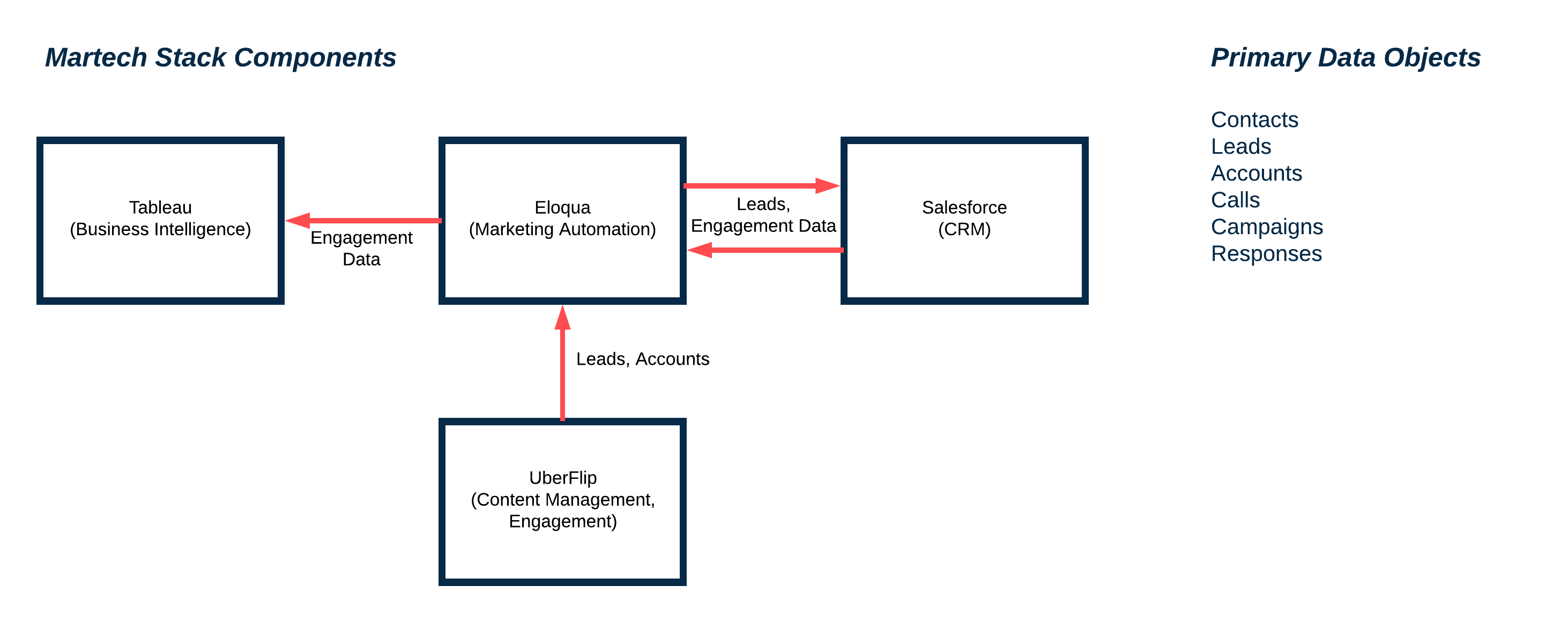[vc_row type=”in_container” full_screen_row_position=”middle” scene_position=”center” text_color=”dark” text_align=”left” overlay_strength=”0.3″ shape_divider_position=”bottom”][vc_column column_padding=”no-extra-padding” column_padding_position=”all” background_color_opacity=”1″ background_hover_color_opacity=”1″ column_shadow=”none” column_border_radius=”none” width=”1/1″ tablet_text_alignment=”default” phone_text_alignment=”default” column_border_width=”none” column_border_style=”solid”][vc_column_text]This 6-part blog series provides a step-by-step guide to help you through the process of conducting a Martech Stack Assessment. In this instalment, Andy Shaw helps you map the connections between the components identified in Step 1.
In Step 1 of the Essential Guide to Martech Stack Assessment Series, Taking Stock, I described the typical components of a marketing technology stack, and walked you through a process for creating a list of the components in your martech stack using a handy workbook. In Step 2, I’ll show you how to characterize the connections between the various technologies.
To conduct a thorough assessment, you need to understand how all the pieces work with each other.
- What kind of data is passed between components?
- What processes are triggered?
- How do the various components help each other succeed?
Answering these questions will give you a better understanding of your martech stack and will help you evaluate its performance. To complete this step, bring in the technical experts for each tool. They might be IT resources, outside consultants, or power users. These are the people who should understand the connections between products, so they should be invited to a working meeting where you’ll create the list of these connections.
Note: If an outside resource was involved in setting up integration for any of the tools, it may not be practical to invite them to your meeting. Check to see if they provided documentation. If not, reach out and ask if they can provide a summary of the initial configuration and some notes.
This is an interactive meeting, so reserve a room that has a whiteboard and that gives you some space to move around. Using the assessment worksheet, draw a box for each technology on the whiteboard. In addition to these technologies, it will be valuable if you identify the main data objects used in your martech stack such as contacts, leads, calls, campaigns, or responses. You can just list these off to the side of your whiteboard as shown in figure 1.

Figure 1. Sample diagram generated from working meeting
The first key action you need to take is to identify which of the components listed is the system of record for the data objects. The system of record is where the master copy of a particular object lives and is responsible for keeping track of the current state of the object and sharing it with other tools. When other tools make changes to the object, they typically will pass the changes on to the system of record so that it can update the master copy. For example, a CRM system, if you have one, is typically the system of record for account data. If other tools receive updates to account data, they pass the changes on to the CRM system so that the master account data can be brought up to date. This data can then be shared with other tools in the stack as needed.
Next, identify the primary connections between components. Try to answer the following questions:
What pieces connect to each other? Identify the components that “talk” to each other. Start by drawing arrows to connect the boxes on your whiteboard. Focus on the most important connections. You don’t need to capture every single byte that is moved between components. Use arrows to indicate the directionality of data flows (e.g., uni- or bi-directional)
What data moves between the components? For each of these connections, try to identify the main types of data that are passed between the components. This information is necessary to an understanding of the overall flow of information within your stack.
Do the components change or enhance this data? Sometimes a tool may update data before passing it on to other components in the stack. For example, a marketing automation system that supports forms may use progressive profiling to enhance a lead or contact’s data over time.
Are any important workflows triggered by the data flows? Passing data to a component can trigger a workflow or set of processes. For example, a new lead passed to the marketing automation system may be enrolled in one or more nurture campaigns or passed on to a CRM system for follow-up by Sales.
How robust is the integration? We’ll talk about this more in the next blog post, but I’d like you to start thinking about how effective the integration is. An integration just for integration’s sake isn’t the point – connections between tools should exist to support your marketing goals.
The second tab on the worksheet gives you a place to record the answers to these questions – there won’t be room for all of this on your whiteboard! Working through this process as a team will give you a good sense of how the different parts of your martech stack work together and help you as a team work better together as well.
In Step 3, The Report Card, we’ll provide a process to guide you through the evaluation and assessment of the different technologies. Can you guess which of your tools pass with flying colors, and ones that don’t make the grade?
Martech Stack Assessment Blog Series;
- Franken-Stack Prevention: An Essential Guide to Martech Stack Assessment.
- Step 1: “Taking Stock”.
- Step 2: “It’s All About Connections”.
- Step 3: “The Report Card”.
- Step 4: “Building a Marketing Technology Assessment Plan”.
- Series Wrap-up: “4 Steps to a Digital Dream Stack”.
[/vc_column_text][/vc_column][/vc_row]
